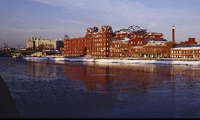 Gagosian Makes Half of Global Sales to Russia, Director Says
Gagosian Makes Half of Global Sales to Russia, Director Says By John Varoli
Sept. 24 (Bloomberg) -- Buyers from Russia and other republics of the former Soviet Union account for almost 50 percent of total global sales at Gagosian Gallery, the art world's global leader in exhibition space, said one of its directors.
Four years ago, it had almost no Russian buyers. Their numbers rose rapidly over the past 18 months, said Victoria Gelfand, director of Gagosian's London gallery, during an interview in Moscow. On Sept. 17, Gagosian opened a show of 70 artworks in a former chocolate factory near the Kremlin.
Russia is the world's second-biggest oil exporter. According to Forbes, the number of Russian billionaires jumped to 110 in 2008 from 36 in 2004. This new wealthy class is eager to spend on luxury items and fine art.
``The bulk of these sales are postwar and contemporary art,'' said Gelfand, who heads operations with Russia. ``These buyers have multiple residences, and basically live on airplanes, as they have business interests around the world.''
Titled ``For What You are About to Receive,'' the current Moscow show is Gagosian's second in the Russian capital and runs until Oct. 25. The gallery said that in the first few days it sold ``about 13'' artworks, each ranging in value from $25,000 to $2 million.
Artists in the show include Alberto Giacometti, Willem de Kooning, Roy Lichtenstein, and Pablo Picasso. There are also new works, never displayed before, by Anish Kapoor, Jeff Koons, Ed Ruscha, Richard Serra, and Cy Twombly. Gelfand said about 50 of the 70 works are for sale.
`Revolutionary Moment'
``We're now seeing a revolutionary moment on the art market,'' said Gelfand, 31, an American citizen born in Belarus. ``People are coming to us and buying who never bought Western contemporary art before.''
Gagosian spent about $1 million to renovate 25,000 square meters on the third floor of the former Red October Chocolate Factory, said Gelfand. The works on display came from artists and estates, or were lent by collectors.
``Russia has a great cultural heritage in literature, music and visual arts,'' said Gelfand. ``In this context it's not surprising Russians learn quickly. Whether it's buying boats, or art, or traveling, Russians have an intense appreciation for life.''
In terms of volume, the more popular artists among Russians over the past two years have been Koons, Richard Prince, Damien Hirst, Takashi Murakami, and Cecily Brown, said Gelfand.
Pop Art
Abstract Expressionism and Pop Art sales to Russians account less in terms of volume, though in terms of value they lead ``because one Rothko, De Kooning or Warhol can fetch a very high price,'' said Gelfand.
``People are looking for a way to invest and enjoy investing, and art is a great way to do that,'' said Gelfand. ``We've seen that even the most prominent stocks can be wiped out, but if you buy a great work by a great artist it'll never lose its value.''
Gagosian has no plans to open a permanent presence in Russia, and it will continue to hold temporary shows.
``We found that the current model of flexible shows is actually working very well for us,'' said Gelfand.
Gagosian's Sept. 17 gala opening came a day after Dasha Zhukova and billionaire Roman Abramovich opened the Garage Center for Contemporary Culture, a non-profit organization that will promote contemporary art and culture in Russia.
Garage's chief coordinator is Mollie Dent-Brocklehurst, a former director of Gagosian in London.
``There's a great friendship and respect between our gallery and the Garage Center for Contemporary Culture,'' said Gelfand. ``We plan to work with the CCC just like with any other museum, and help our artists make shows happen by finding financing, securing works from collections, and logistics.''
(John Varoli writes for Bloomberg News. Opinions expressed are his own.)
To contact the writer on the story: John Varoli in St. Petersburg at jvaroli@gmail.com.
Last Updated: September 23, 2008 19:51 EDT
 Gagosian Makes Half of Global Sales to Russia, Director Says
Gagosian Makes Half of Global Sales to Russia, Director Says